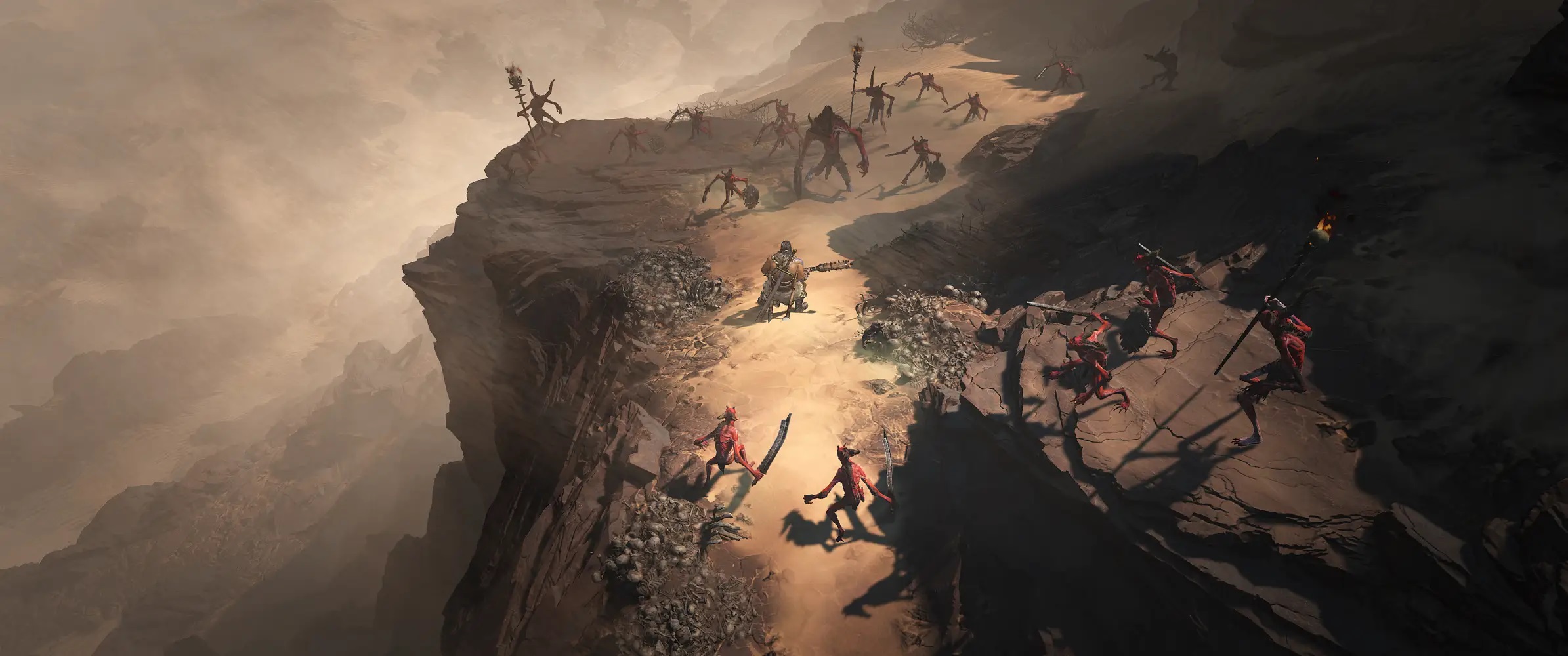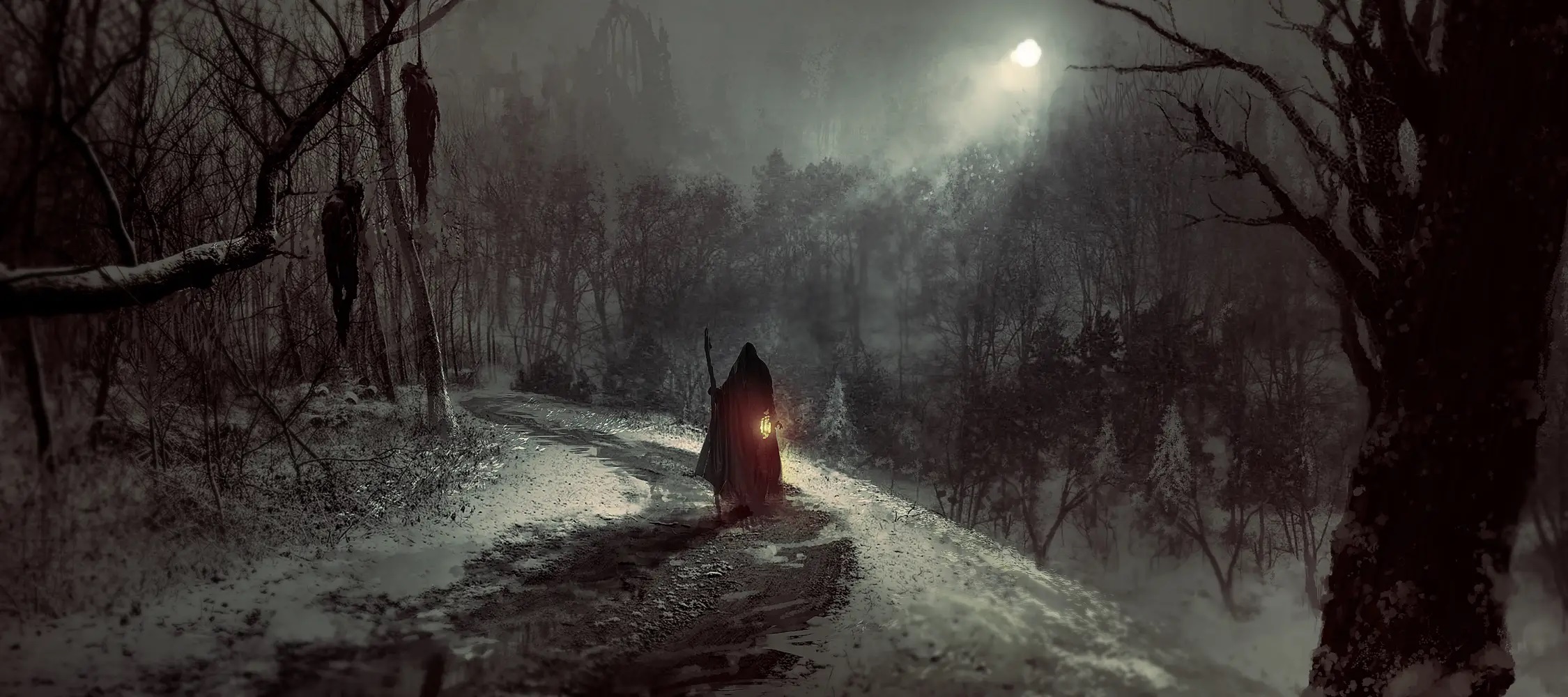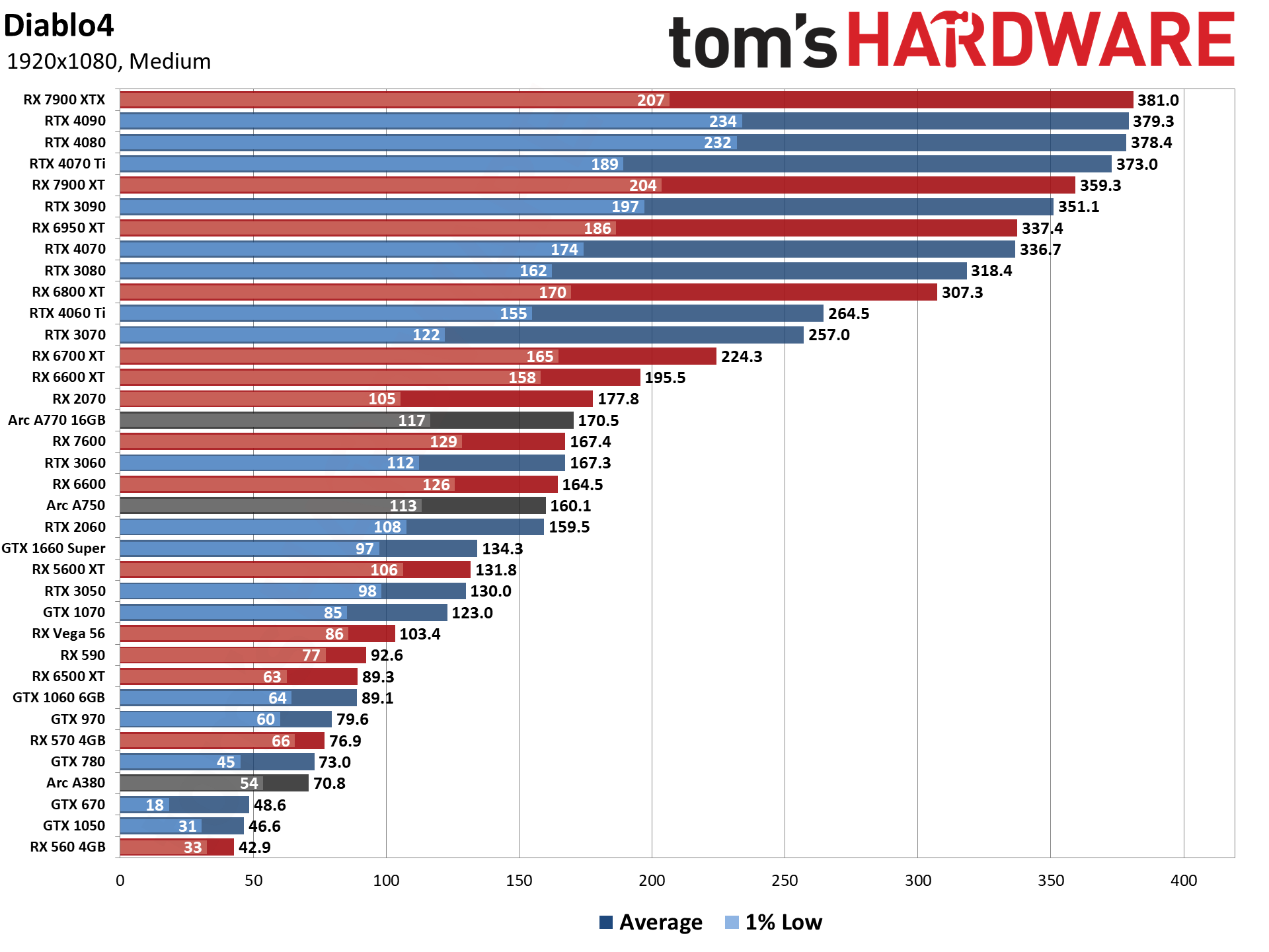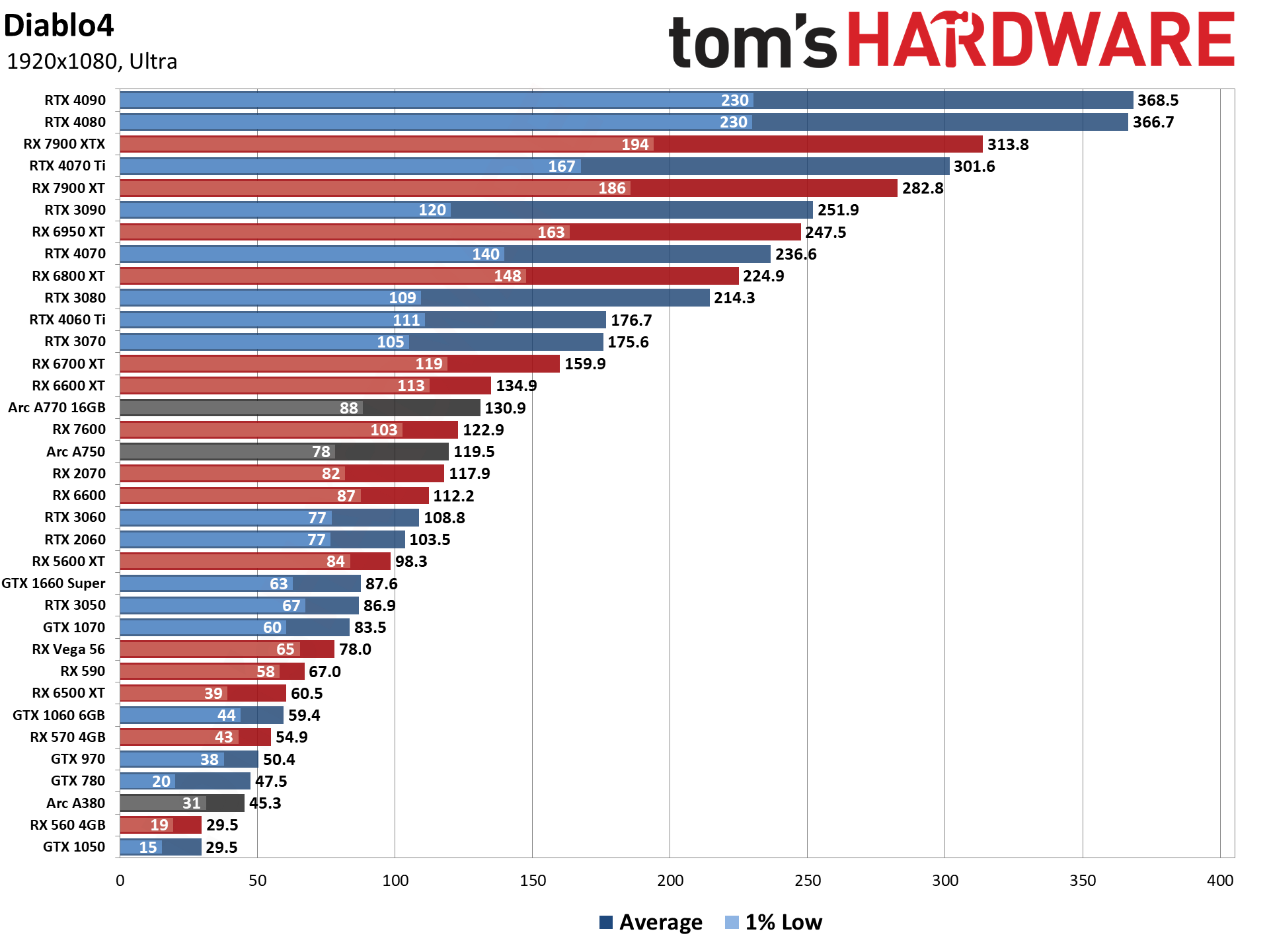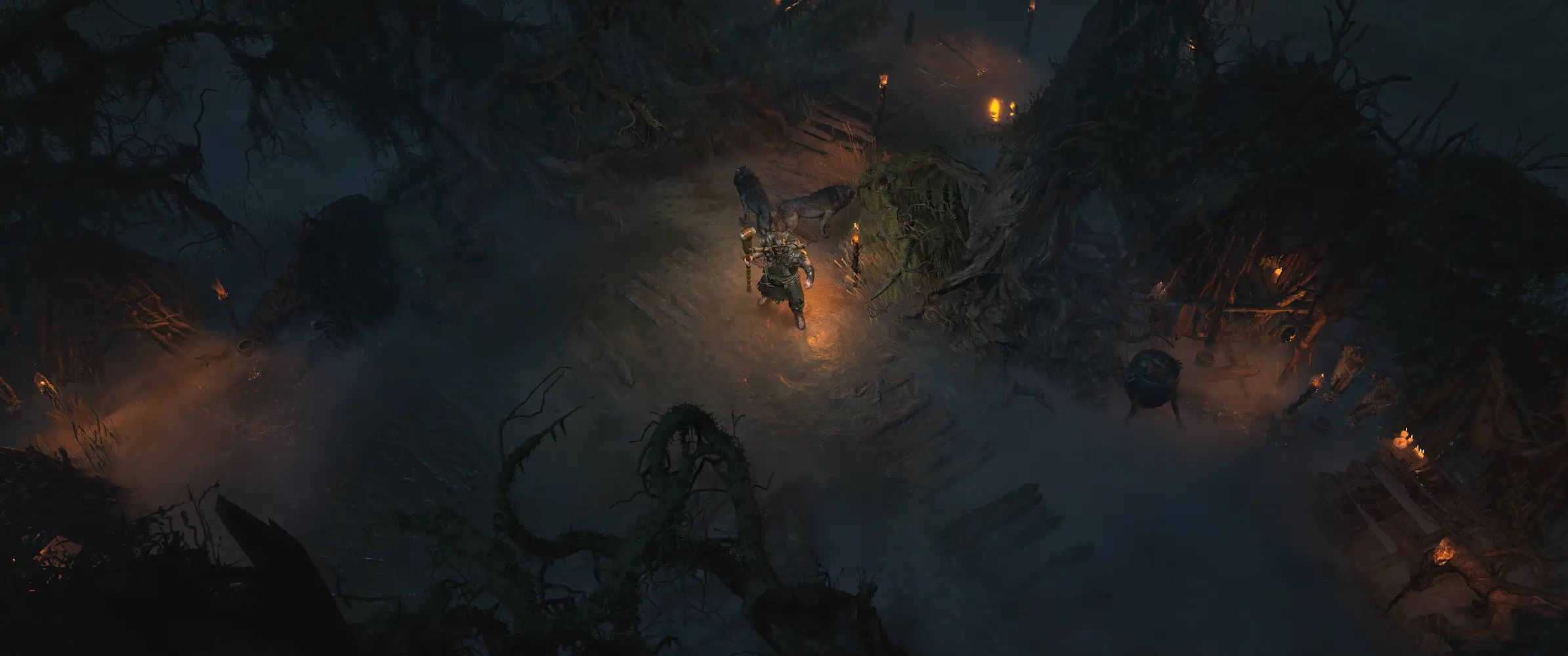Diablo IV PC Performance: 36 GPUs Benchmarked
What sort of a graphics card will you need to run Diablo IV?
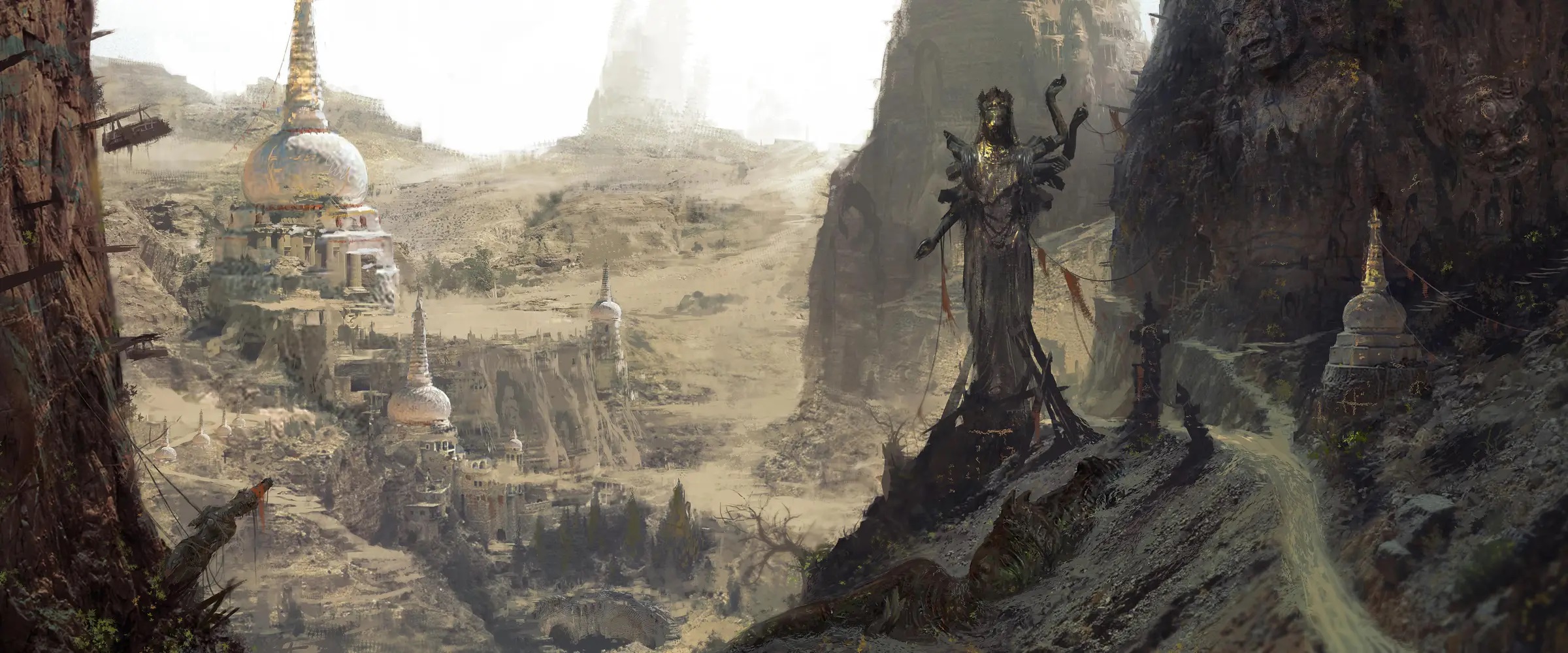
Diablo IV — Introduction
Diablo IV has arrived, eleven years after its predecessor. The game launched in "early access," for people that are willing to fork over the extra money to buy the Deluxe or Ultimate editions. We got an Ultimate code for testing purposes, and the game unlocked at 4pm PDT on June 1. Then the benchmarking fun began. How does it run, and what sort of hardware will you need? That's what we aim to find out.
A lot has changed in the past decade, especially in the world of PC hardware. The fastest PC back in mid-2012 consisted of a shiny new Core i7-3770K, paired with a Radeon HD 7970 or GeForce GTX 680. Or maybe a Core i7-3960X if you were into HEDT setups, with a dual-GPU GeForce GTX 690 or Radeon HD 6990? Typical PCs would have 8GB of memory, while high-end systems might come with 16GB. Most people were still using a best hard drive rather than SSDs, typically of the 250GB to 500GB variety.
But it's not just the hardware that's changed. We've gone from Windows 7 to Windows 8/8.1, 10, and 11. Microtransactions were a relatively new thing back in 2012, buying digital cosmetics was scorned, and live service games weren't a thing. It's a brave new world for Diablo IV, in other words.
6/5, 7:45am PDT: We've basically finished testing all the GPUs now. I just added R9 270 results to the 720p/1080p Low chart. Anything that's missing should be reasonably close to one of the other GPUs that we've tested. If you have any specific requests for other GPUs, let us know in the comments.
We've tested a lot of graphics cards, 36 to be exact, spanning about a twelve year range. If you don't see your GPU tested and you'd like us to run some benchmarks, make a request in the article comments. We can't test everything, but come on: This is Diablo! There are millions of people wanting to play the game, with everything from a maxed out extreme gaming PC down to a portable potato.
We've tried to include at least one GPU from each generation going back to about 2015, with a few extras from even earlier generations. We've tested AMD, Nvidia, and Intel GPUs. We didn't have time for testing integrated graphics (yet).
Diablo IV — System Requirements
The official Diablo IV system requirements don't look too onerous. In fact, even a PC from 2012 might conceivably run the game. Here's the breakdown.
Minimum PC Requirements
- Intel Core i5-2500K or AMD FX-8350
- Nvidia GeForce GTX 660 or AMD Radeon R9 280
- 8GB of system memory
- SSD with 90GB of available space
- Windows 10 64-bit version 1909 or later
- DirectX 12
- Broadband internet
Blizzard says a minimum spec PC will manage 30 fps with 720p, upscaled to 1080p, at low settings. We're... not going to test the minimum spec PC. At least not first. Mostly because we don't have most of those parts hanging around. We'll leave that as an exercise for the internet at large for now, so if you have such a system, sound off in our forums on how it runs!
There are a few interesting pieces of information, though. For example, the CPUs are very old by today's standards, and the GPUs both stopped getting driver updates in the past year or two. Is Blizzard testing with the final AMD 22.6.1 and Nvidia 474.30 drivers? We don't know. (Note that Nvidia has released security updates for some older GPUs like the GTX 660, with the last driver from March 2023, but the last "Game Ready" release was 472.12 from September 2021.) Also, the R9 280 was, literally, a rebadged Radeon HD 7950 Boost, which means technically you could go back a bit further on the GPU side of things.
The DirectX 12 requirement is a bit interesting as well, as some of those older GPUs were potentially problematic. There's DX12 compatible, and then there's GPUs that actually work well with DX12. Cards with less than 4GB have always been a bit problematic with DX12 games in my experience.
8GB of system memory shouldn't be a problem for most people — Windows itself tends to want at least 8GB to run well, unless you're doing something like a Tiny 11 installation. Likewise, 90GB of free space isn't too bad these days when you can pick up a 2TB SSD for $75 (that's for the Solidigm P41 Plus that we reviewed and found to be okay, given the capacity and price).
Recommended (Medium) PC Requirements
- Intel Core i5-4670K or AMD Ryzen 3 1300X
- Nvidia GeForce GTX 970 or AMD Radeon RX 470
- 16GB of system memory
Stepping up to the recommended specs, you'll need a CPU from about 2014 or later on the Intel side, or a first generation quad-core Ryzen CPU from AMD. Either way, those are CPUs that don't have SMT / Hyper-Threading. And they're still enough for 60 fps at 1080p and medium settings. It seems like Diablo IV won't be too much of a resource pig, if these recommendations are anything to go by.
Graphics card suggestions get a bump up to 4GB cards now, but the GTX 970 is still pretty ancient by today's standards, having launched in 2014. Then again, it's about as fast as a GTX 1650 from 2019, which isn't that old.
Blizzard also bumps the RAM recommendation to 16GB, which is what we'd recommend for most people anyway. Windows just feels so much nicer on 16GB (or more) memory. The rest of the requirements remain unchanged, so we've dropped them from the list.
High PC Requirements
- Intel Core i7-8700K or AMD Ryzen 7 2700X
- Nvidia GeForce RTX 2060 or AMD Radeon RX 5700 XT
- 16GB of system memory
Blizzard's high recommended specs are for 1080p at high settings, still aiming for 60 fps. The components are now from about 2018 (give or take). The CPUs are either a 6-core/12-thread Intel chip, or an 8-core/16-thread AMD chip, from several generations back.
GPUs are also a couple of generations old, with the RTX 2060 and RX 5700 XT. If we were picking nits, we'd point out that, based on our GPU benchmarks hierarchy, for non-ray tracing games the RX 5700 XT ends up being about 30% faster than the RTX 2060. It also has 2GB more VRAM.
Then again, Diablo IV has DLSS 3 support, which means it also supports DLSS 2 upscaling and that typically boosts RTX 2060 performance by 30%. But there's no indication of whether Blizzard is factoring in DLSS or not.
Ultra 4K PC Requirements
Get Tom's Hardware's best news and in-depth reviews, straight to your inbox.
- Intel Core i7-8700K or AMD Ryzen 7 2700X
- Nvidia GeForce RTX 3080 or AMD Radeon RX 6800 XT
- 32GB of system memory
Finally, for 4K ultra at 60 fps, the only changes are that Blizzard recommends 32GB of system memory, and you'll need a beefier GPU: RTX 3080 or RX 6800 XT. Those are at least roughly comparable, though it's worth mentioning that Diablo IV won't support ray tracing at launch — that will come later, according to Nvidia.
In our rasterization test suite, the RTX 3080 ends up being 5% faster than the RX 6800 XT at 4K ultra. Once the game gets ray tracing support, that lead could grow to 50% or more, depending on how demanding the ray tracing is. Factor in DLSS upscaling (we're not sure if Diablo IV supports FSR 2 yet) and it could be an even bigger gap. But we'll see how the game runs soon enough.
Diablo IV — Test Setup
TOM'S HARDWARE TEST PC
Intel Core i9-13900K
MSI MEG Z790 Ace DDR5
G.Skill Trident Z5 2x16GB DDR5-6600 CL34
Sabrent Rocket 4 Plus-G 4TB
be quiet! 1500W Dark Power Pro 12
Cooler Master PL360 Flux
Windows 11 Pro 64-bit
Samsung Neo G8 32
GRAPHICS CARDS
AMD RX 7900 XTX
AMD RX 7900 XT
AMD RX 7600
AMD RX 6000-Series
Intel Arc A770 16GB
Intel Arc A750
Intel Arc A380
Nvidia RTX 4090
Nvidia RTX 4080
Nvidia RTX 4070 Ti
Nvidia RTX 4070
Nvidia RTX 4060 Ti
Nvidia RTX 30-Series
We're using our standard 2023 GPU test PC, with a Core i9-13900K and all the other bells and whistles. We're planning on testing Diablo IV on a lot of graphics cards, but the boxout only shows relatively recent GPUs.
We'll be testing at 1920x1080, 2560x1440, and 3840x2160. For low-end cards (as in, old stuff like the GTX 660 or similar), we may also test at 720p and low settings. For the remaining cards, we'll test at 1080p with the medium and ultra presets, the ultra as well at 1440p and 4K. We'll also test with DLSS and FSR 2 as appropriate, depending on how things shake out.
We'll start at the lower settings and work our way up, and once a GPU hits sub-30 fps performance, we'll stop and move on to the next card. As for how we test, we're running around the first major city, which so far seems to be one of the more demanding areas. Minimum fps can vary a fare amount between runs, but the average fps seems relatively consistent. There may be more demanding areas later in the game, but at some point we just need to start testing.
It's worth pointing out that Diablo IV isn't a twitch game, at least not at the same level as a first-person shooter. It's relatively forgiving of lower fps, so 30 fps and above are playable. We've been testing on a 240 Hz 4K monitor (Samsung Odyssey Neo G8 32-inch), and anything above 60 fps feels fine. Things are a bit smoother at 120 fps an higher, but it doesn't add too much to the experience.
Diablo IV Graphics Card Performance
Our test consists of a ran around a section of Kyovashad, which so far is the most taxing section of the game we've encountered. Other areas might be more demanding, but we wanted to start testing rather than playing for a few days. (Actually, we just wanted to keep playing, but duty called... these benchmarks aren't going to run themselves!)
We've also added some images comparing the various settings below. The short summary is that the Low present looks pretty poor. Yes, it can run on a PC from 2013. It also looks a lot like a game from 2013, with low resolution textures that look very dull. Medium only looks a bit better, while the High and Ultra presets look pretty similar and are generally good. But this is definitely a game designed more for the masses than to push graphics fidelity to new heights.
Diablo IV — 720p/1080p Low Performance
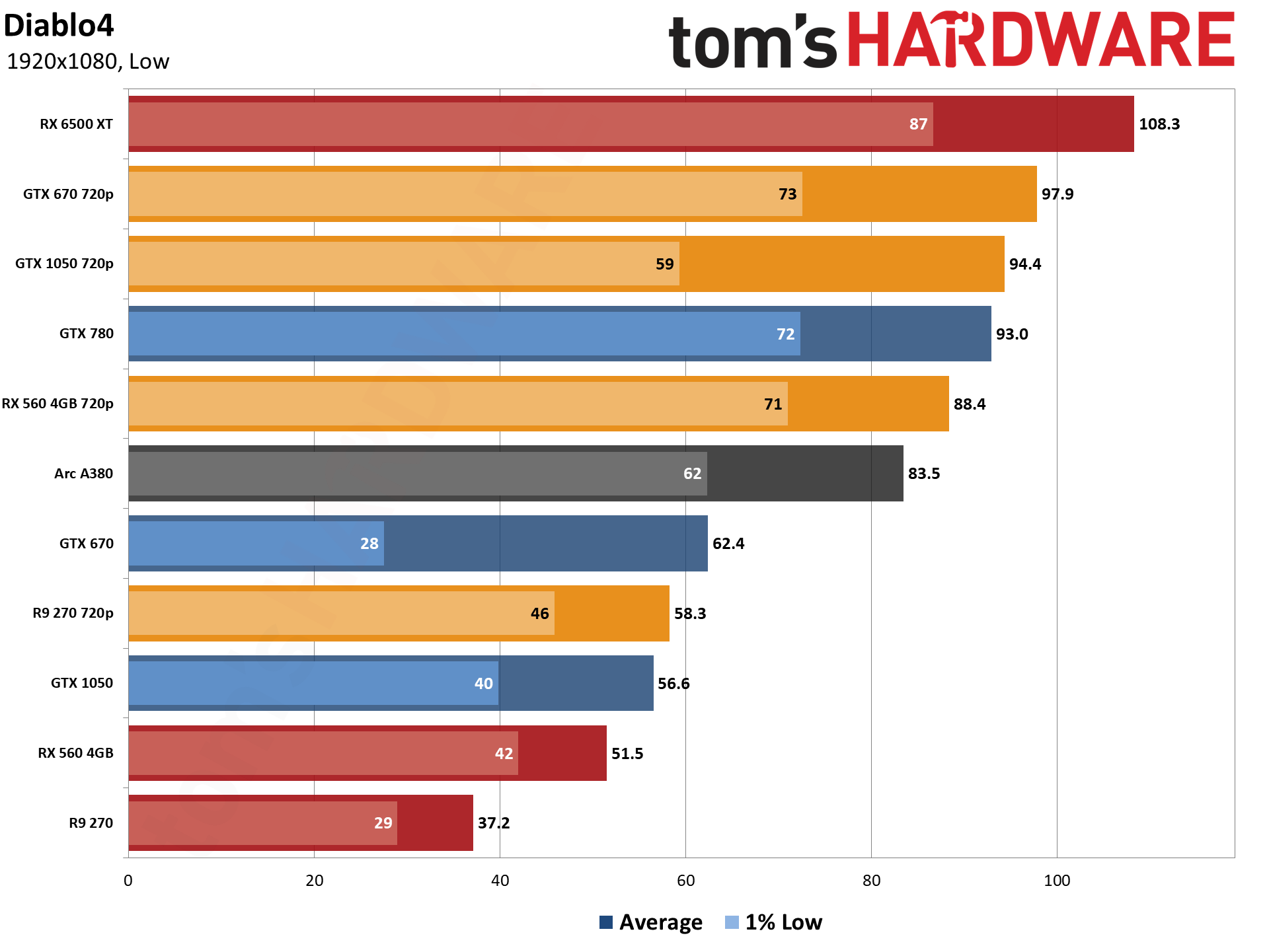
As you might expect, just about any GPU worth a dime can handle Diablo IV at 720p and Low settings (the gold bars in the chart), and most will manage 1080p Low as well. AMD's RX 560 4GB and R9 270 (2GB) are at the bottom of the chart, followed by Nvidia's GTX 1050 (2GB) for 1080p performance. Cards with 2GB of VRAM can also experience some stuttering. The GTX 780 with 3GB of VRAM on the other hand does just fine at 1080p Low.
Intel's A380 comes in just behind the GTX 780 at these settings, though it may do a bit better at higher settings since it has 6GB of VRAM. The RX 6500 XT with 4GB of memory also cruises past these settings.
We don't have all of the super old GPUs available, so for example I found an R9 270 but couldn't find an R9 280. Diablo IV doesn't actually list the R9 270 as being supported, though based on other benchmarks it should actually be faster than a GTX 660, which does have support. I also don't have a GTX 660 around, but I did find a GTX 670, so that's what I used for testing. (As another aside, AMD's R9 270 isn't supported properly by the most recent 22.6.1 drivers, even though it should be; I had to use 21.5.1 drivers and pass Diablo IV the "--bypassgpudrivercheck" option to get it to run.) Either way, you'll want to stick with the recommended 720p Low on such hardware.
It's worth noting that playing with a slow GPU and a slow CPU could result in quite a bit lower performance. We've been using a Core i9-13900K with our testing, to remove CPU bottlenecks as much as possible. Plenty of slower CPUs should still be able to get well over 100 fps, though, provided your GPU is capable.
Diablo IV — 1080p Medium Performance
We've tested a lot of high-end cards, though we didn't hit everything. You should be able to interpolate as needed. Rest assured the RTX 2080, GTX 1080 Ti, and plenty of other GPUs will do just fine at 1080p Medium in Diablo IV. In fact, many GPUs are overkill for this resolution. After seeing what some of the fastest GPUs could do, we opted to add in quite a few lower spec options to see how they fared. The RTX 4060 Ti for example breezes along, so you can safely assume other 40-series GPUs will do just fine.
Everything from the GTX 780, RX 570 4GB, and Arc A380 and above can manage 60+ fps, with the 570 and above keeping 1% lows above that mark as well. If that's all you're hoping for — or all your monitor can handle, if you have a 60 Hz display — nearly every midrange or higher GPU from the past five or more years should be sufficient. Just watch out for things like the GTX 1050, as its 2GB VRAM can be a problem.
Diablo IV — 1080p Ultra Performance
Bumping up to the Ultra preset, cards with less than 6GB can start to struggle, even at 1080p. The Arc A380 also falls close to 30 fps at times, but not for a lack of VRAM — raw compute still matters as well. The RX Vega 56 and above are still able to provided a smooth 60+ fps, and RX 590 just about gets there, so there are plenty of options out there if you game at 1080p.
It's interesting to note that the GTX 1660 Super is basically as fast as the RTX 3050. That's without DLSS enabled, naturally. The GTX 1060 6GB and GTX 970 can still easily break 30 fps, but cards with 3GB VRAM like the GTX 780 start to get choppy at times, as evidenced by the 20 fps 1% low result.
Diablo IV — 1440p Ultra Performance
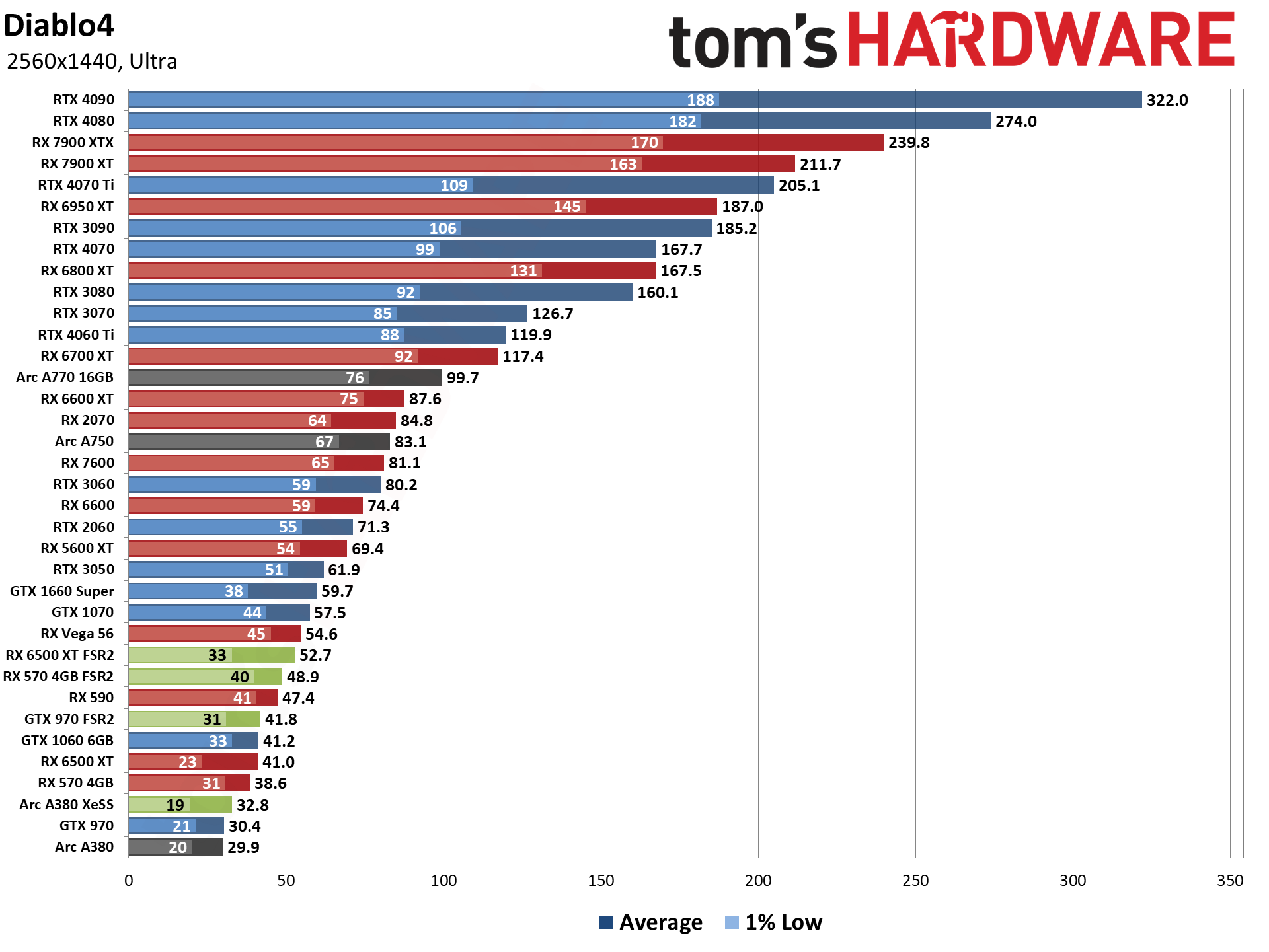
Some of the GPUs start to really struggle at 1440p Ultra. We've included a few upscaling results for the slower GPUs (using Quality mode on the green bars). But there are plenty of cards still doing well.
The GTX 1660 Super comes up just shy of 60 fps, while RTX 3050 and up can still break 60 fps — perhaps with a bit of sluggishness now and then, depending on the area. (Again, DLSS would help quite a bit.) We're testing in Kyovashad, as that seemed to be more of a stress test than the surrounding areas. YMMV.
RX 7600 and up easily clear 60 fps, and the RTX 4060 Ti averages 120 fps, so 8GB of VRAM isn't an issue in Diablo IV. Intel's Arc A750 and A770 Limited Edition also handle 1440p Ultra without issue.
Diablo IV — 4K Ultra Performance
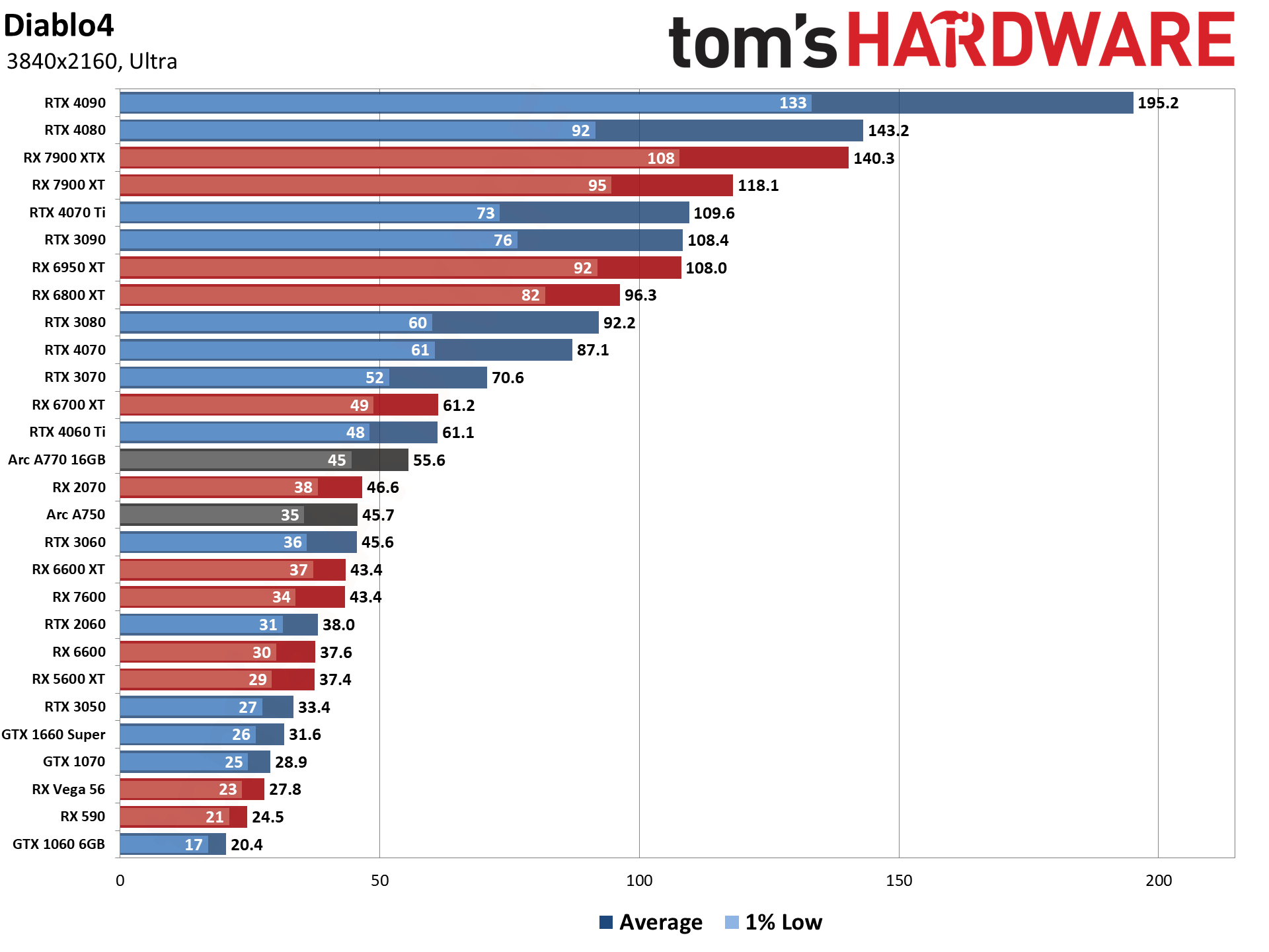
4K Ultra still ends up being fairly demanding, with the RTX 4060 Ti averaging just over 60 fps, but with 1% lows of 48 fps. The other RTX 40-series cards do fine, and we'll see below that DLSS, FSR 2, and XeSS can help more GPUs remain playable even at the current maximum quality settings.
Of the GPUs we've tested, RTX 4070 and above are all staying above 60 fps and provide a great experience in Diablo IV. And if you have an RTX 4090 or 4080, congratulations: Your GPU is plenty fast!
Note that ray tracing is planned for a future update. Whether or not it will make a big difference in visual quality remains to be seen, and we'll have to see what sort of performance impact it creates. Lesser GPUs might want to use upscaling with ray tracing to get good performance at 1440.
If all you want is 30 fps, even the GTX 1660 Super and above can suffice. The GTX 1060 6GB does come up short, sadly. Still, it doesn't do too bad for a midrange GPU from seven years ago. Curiously, the RX Vega 56 also didn't do that well, falling to 28 fps — normally, it should match the GTX 1070, which is significantly faster than the GTX 1060 6GB. It's not exactly clear what's holding AMD's older GPUs back, but certainly architectural advances play a role at 4K.
Diablo IV — 4K Upscaled Performance
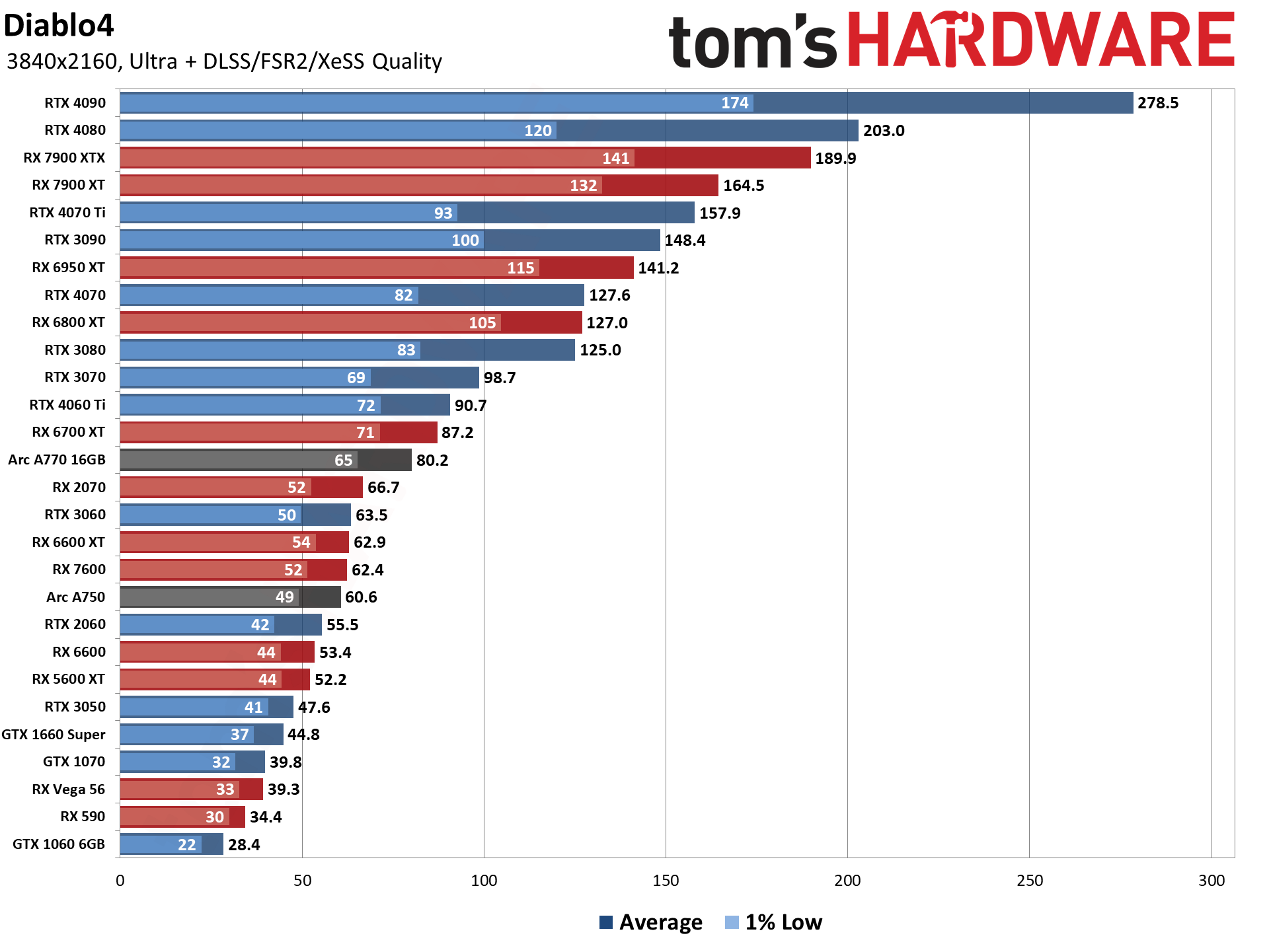
Wrapping things up, we have 4K with DLSS 2 / FSR 2.1 / XeSS Quality mode upscaling — and Diablo IV won't let you pick and choose, so RTX cards have to use DLSS, Arc cards have to use XeSS, and everything else can use FSR 2.1.
Upscaling gets all the RTX cards in the chart above 30 fps, but the GTX 1060 still doesn't break 30 fps. It would need a higher level of FSR 2 upscaling to get there, but the GTX 1070 and above should still do fine. Note that the 4K upscaling and 4K native charts look mostly the same, meaning all of the GPUs see similar gains from upscaling. There are a few exceptions, however, like the Arc A760 — the A770 16GB benefits far more from XeSS, probably thanks to its additional memory.
One cool thing is that if you have an RTX 4090 and a 4K 240 Hz monitor, you can actually make decent use of the display! Playing Diablo IV that way is quite nice, though I'm not sure it's that much better than on a 4K 120 Hz display.
Incidentally, DLSS 3 Frame Generation doesn't seem to be working right. Or maybe there's some special combination of steps to make it run better? Anyway, the RTX 4090 ended up getting 240 fps with upscaling and Frame Generation enabled, though the 1% lows were higher at around 190 fps. Other 40-series GPUs showed similar behavior, with improved minimum fps but reduced average fps. Latency logging via FrameView was also not working, but it's safe to assume that Frame Generation adds latency as well.
As a potentially better alternative for those with high-end Nvidia GPUs, turning on DLAA instead of DLSS is worth considering. You get the anti-aliasing and sharpening of DLSS, but without upscaling, giving the best overall image quality. And with FrameGen on an RTX 4090, 4K Ultra with DLAA still got over 200 fps.
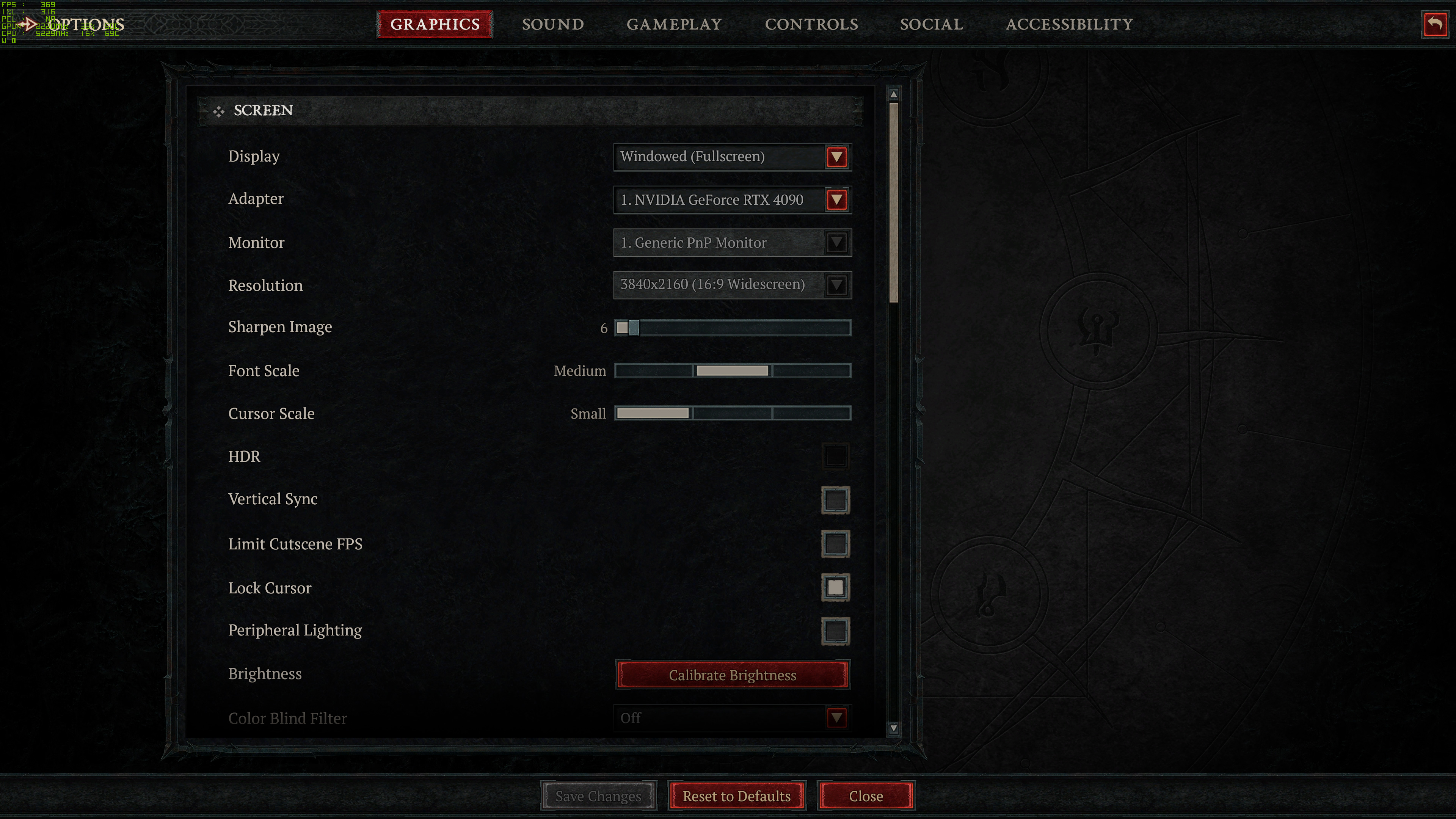
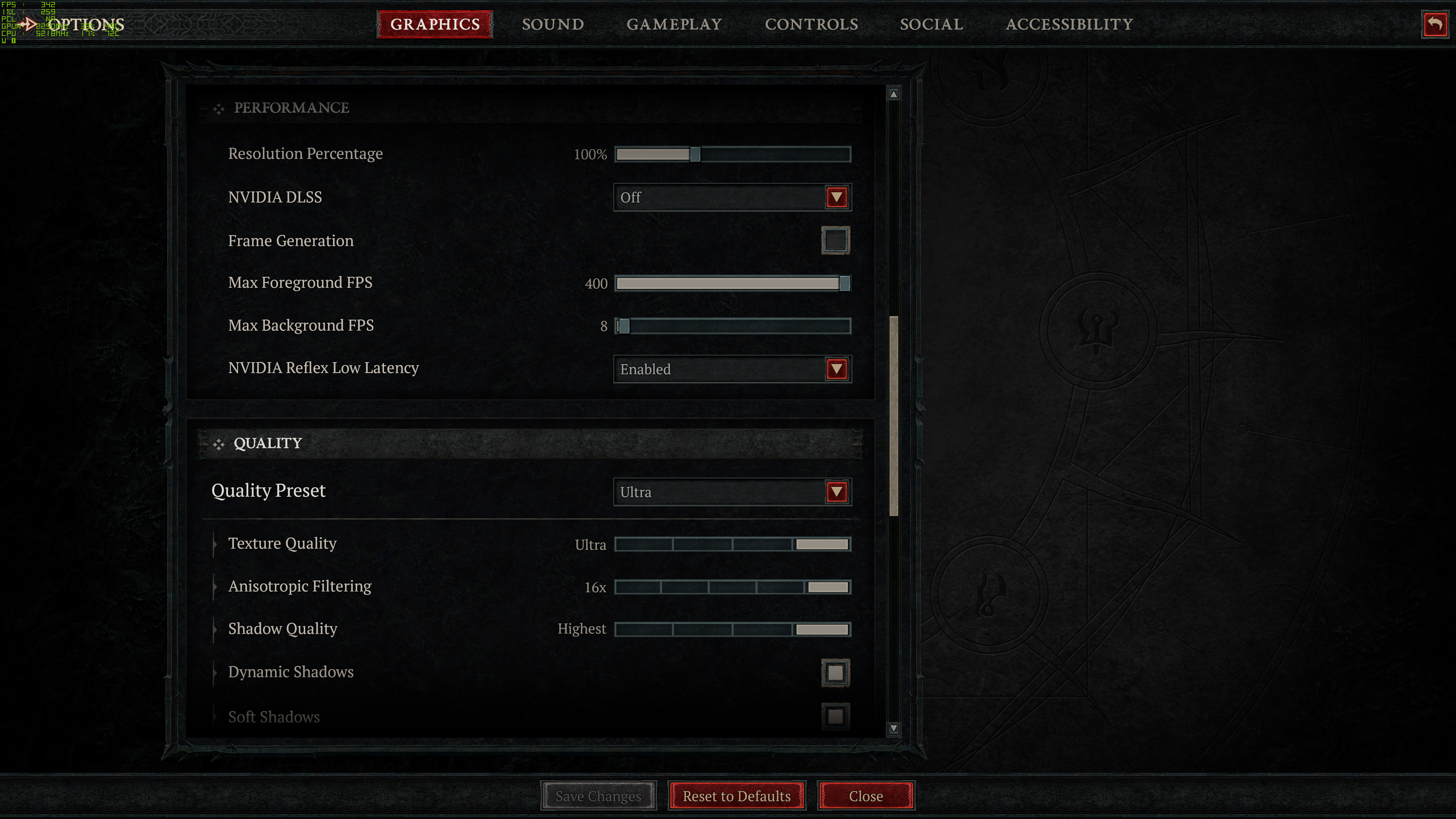
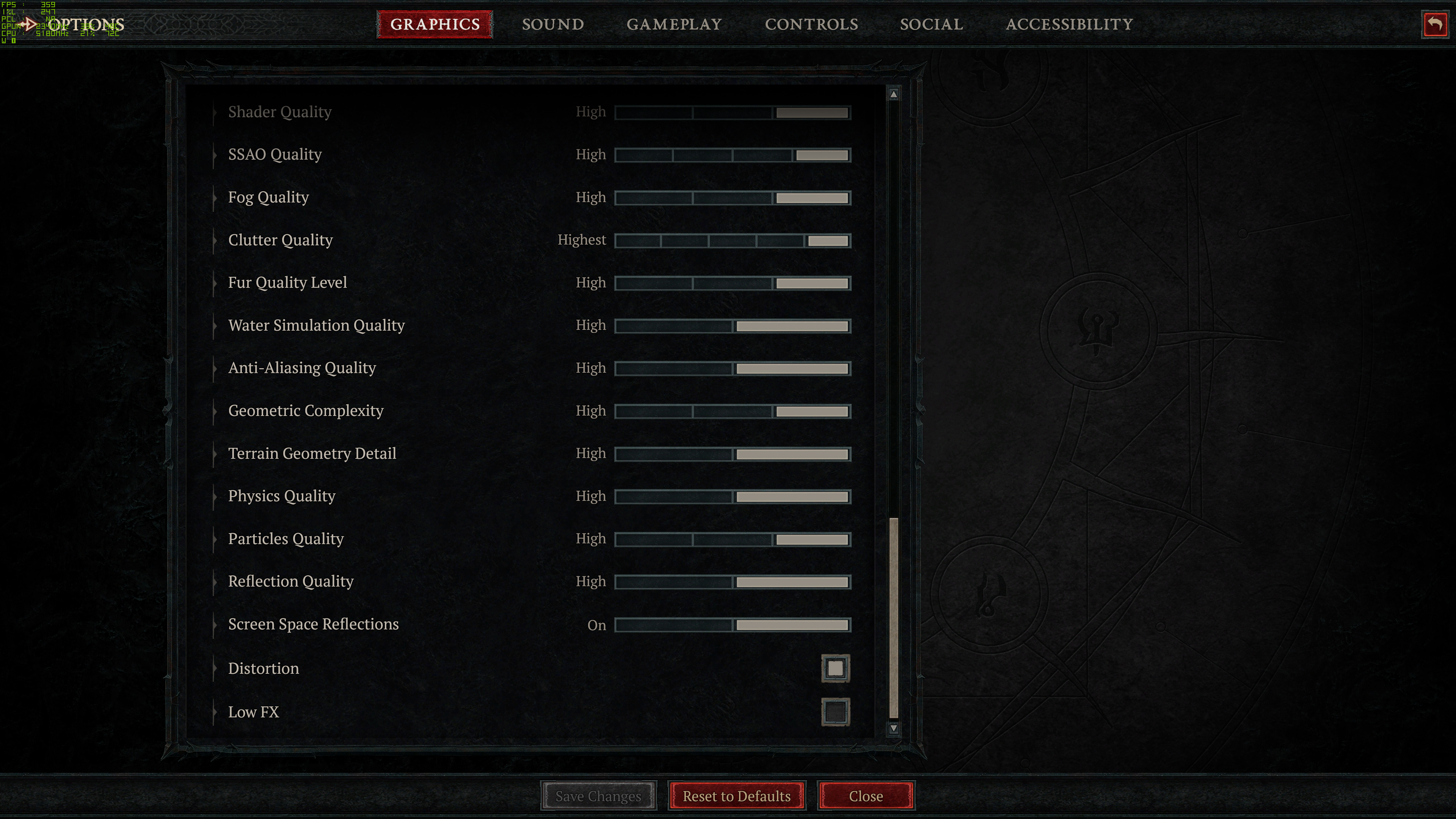
Diablo IV — Settings and Image Quality
Diablo IV offers a variety of settings to tweak, along with the usual four presets (Low, Medium, High, and Ultra). Besides the presets, there are about twenty other settings you can tune (depending on what you want to include). There is a framerate cap, which defaults to 150, but you can set it as high as 400 — sorry, 480 Hz display owners!
Diablo IV supports DLSS 3, which means it has support for Nvidia upscaling, Frame Generation, and Reflex. For AMD and non-RTX Nvidia cards, you can use FSR 2.1 upscaling. Finally, XeSS is supported on Intel Arc GPUs. All of the upscaling solutions looked okay to us at the Quality mode preset.
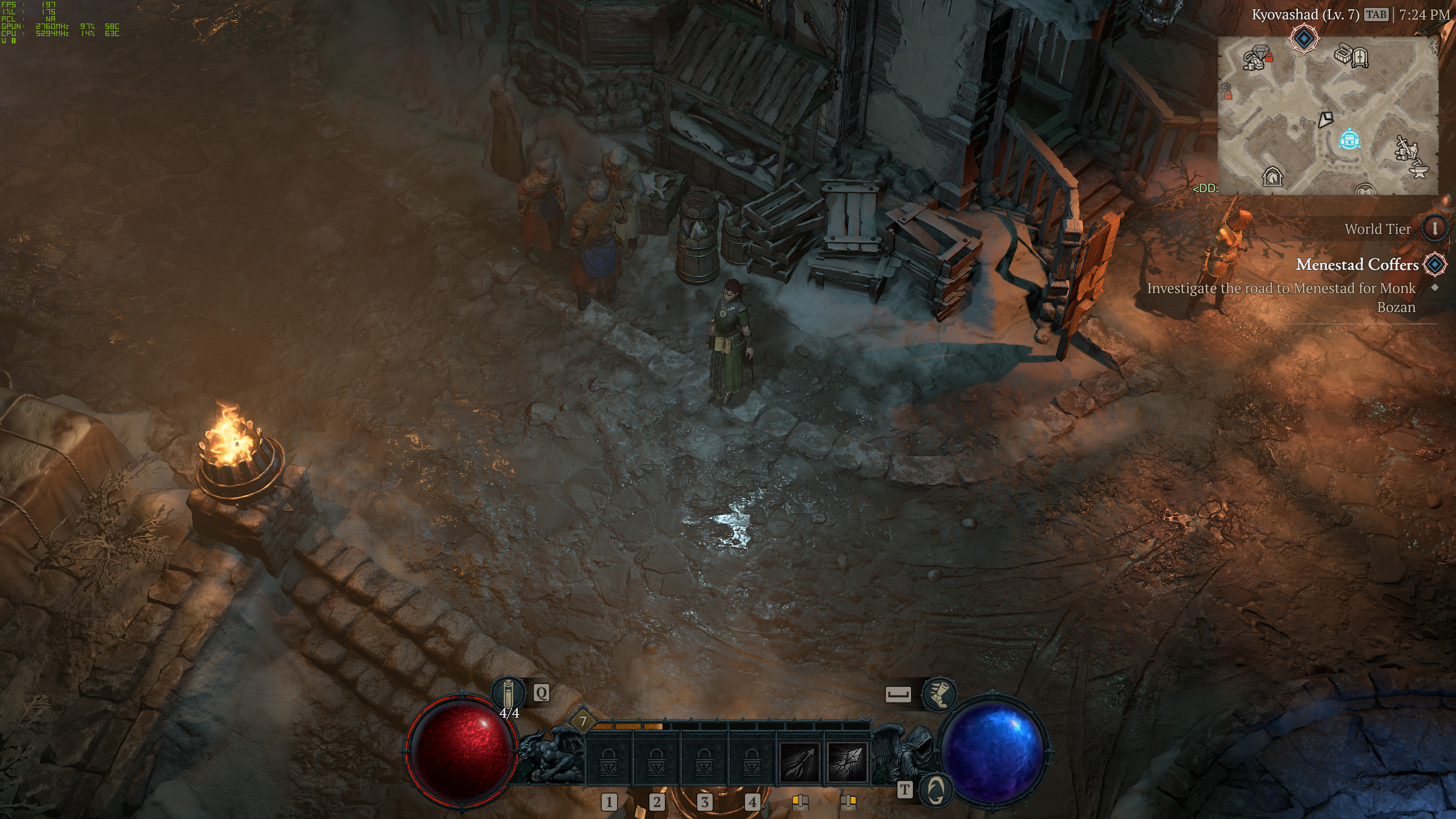

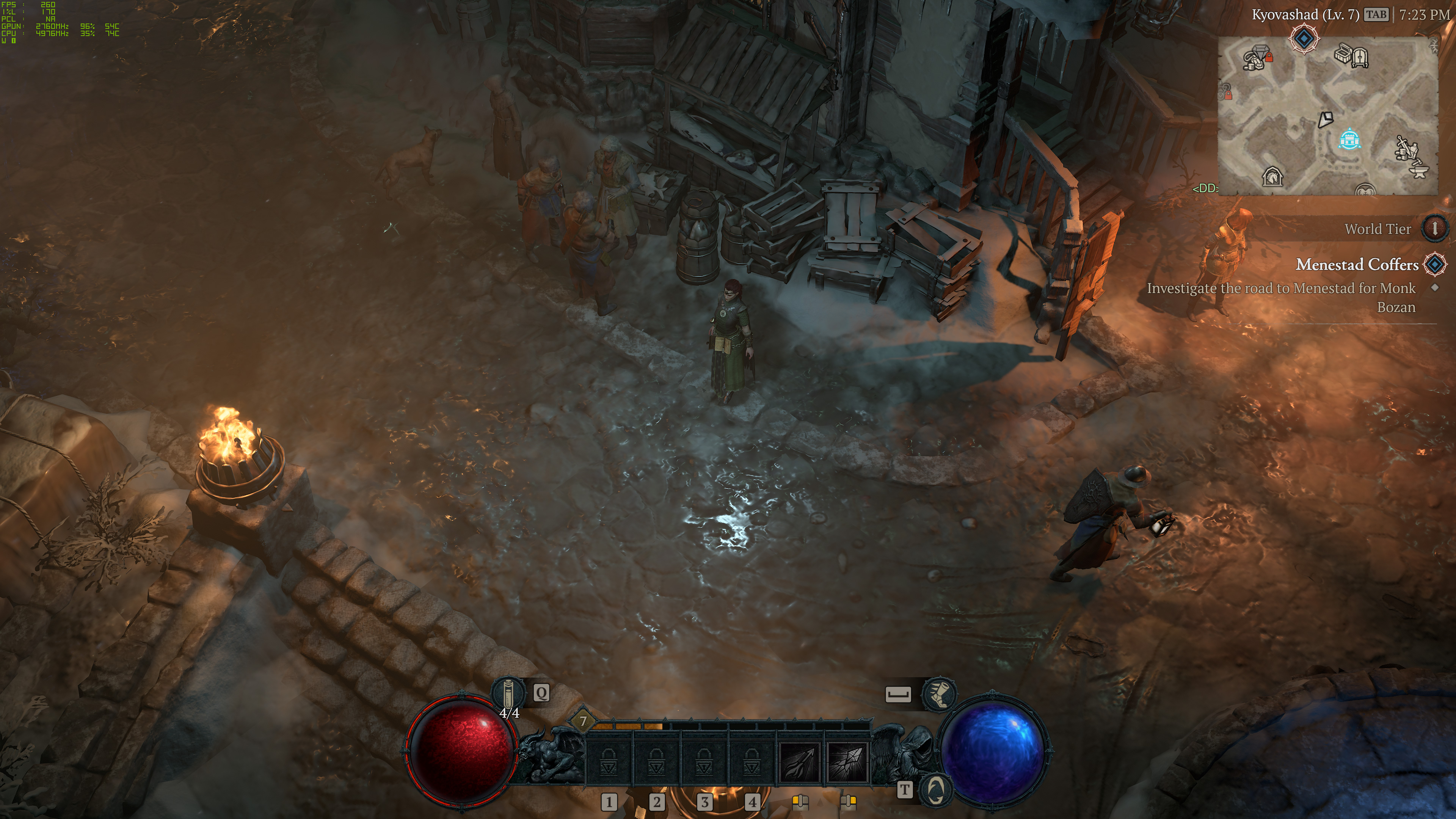
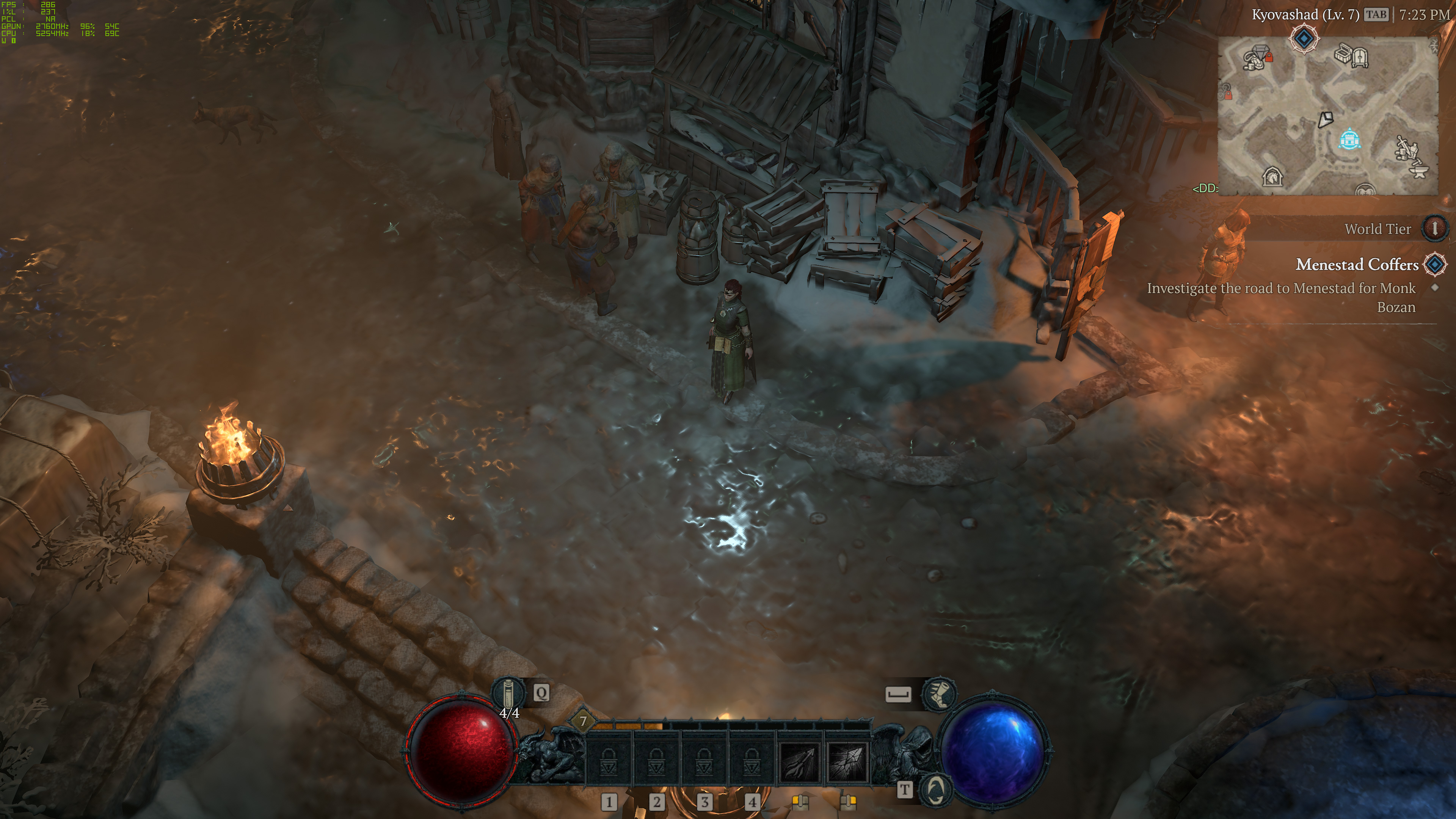
We'll add more detail in the future, but here's a quick look at the four presets. While Ultra and High look pretty similar, you can still see a slight reduction in texture quality as well as less detail on some of the environment (like the plant toward the bottom left).
Dropping from High to Medium brings a further reduction in texture quality and overall image fidelity, while the Low preset looks pretty bad. The road loses almost all of its detail. You can still play Diablo IV even at minimum quality and enjoy the game, but some of the pyrotechnics and other visual effects get lost.
Diablo IV — Early Thoughts
We haven't played through a lot of Diablo IV yet, but so far the city of Kyovashad has been more taxing than anything we've seen running around the first few areas. Most of the GPUs were easily pulling 60 fps or more. Granted, we're using a fast CPU, but this isn't a super taxing game by modern standards. That's why we opted to run some of the slower GPUs through our testing first.
As far as the game itself, it's Diablo, with some modernized options. PC Gamer's Diablo IV review-in-progress seems underwhelmed with the live service nature and "just wait for the end game" design philosophy. It hasn't scored the game yet, opting to wait for the retail launch. At the other end of the spectrum, GamesRadar+ gave Diablo IV an editor's choice 5-star review and calls it "a magnificent and absurd loot theme park," though it reviewed the Xbox Series X version. Overall, the current Metacritic score of 88 for the PC version looks quite favorable.
Performance and system requirements are mostly a non-issue, unless you haven't upgraded your PC or graphics card in over a decade. High-end gaming PCs won't have any issues running Diablo IV at maxed out settings... for now. We'll have to see how things change when the ray tracing update comes out, and hopefully it will provide some wonderfully enhanced visuals rather than just slightly nicer shadows.
Anyway, we're done with testing now and there should be enough data to extrapolate where any of the GPUs we've skipped would land. Basically, any RTX card can do 4K with upscaling at reasonable levels of performance, and the faster cards can easily get into the triple digits. But if you really want your particular GPU tested, write a note in the comments.

Jarred Walton is a senior editor at Tom's Hardware focusing on everything GPU. He has been working as a tech journalist since 2004, writing for AnandTech, Maximum PC, and PC Gamer. From the first S3 Virge '3D decelerators' to today's GPUs, Jarred keeps up with all the latest graphics trends and is the one to ask about game performance.
-
CelicaGT It appears FSR 2.1 should be supported. Source is AMD.com, Reddit, D4 forums, as well as several other lesser known forums/sites.Reply -
ezst036 ReplyAdmin said:We're Testing a Bunch of GPUs
Is that out of the norm for a website like this? How is that headline news? -
zipspyder Just an FYI. I was playing the beta's on an intel laptop with UHD630 igpu and it ran fine at low and a couple medium settings. I don't know the fps but it was smooth enough to enjoy the game,.Reply -
JarredWaltonGPU Reply
Fixed. The closing said 7pm EDT, I could have sworn I had the right time in the intro as well, but apparently not. I live in MDT, others in EDT or CDT, so it can get a bit confusing at times. LOLdbaronezn said:4PM PDT, not 6PM
Yeah, I'll be checking whatever options are available, as appropriate. Meaning, DLSS on Nvidia and FSR2 on AMD/Intel GPUs.CelicaGT said:It appears FSR 2.1 should be supported. Source is AMD.com, Reddit, D4 forums, as well as several other lesser known forums/sites.
Gee, it's almost like Diablo IV is a major game that a ton of people will want to play, and that doing an article on performance is something people who come to Tom's Hardware would like to see. If you don't care about seeing benchmarks (when I'm able to test), why bother to come and comment?ezst036 said:Is that out of the norm for a website like this? How is that headline news?
Oops! I corrected several of these when I wrote this up yesterday. My muscle memory is way more tuned to writing "VI" than "IV" (Nvidia for example is vi). I blame my editor for not catching the other errors, but at least it was in the subtitle and not the headline!bourgeoisdude said:Title shows Diablo VI. Now that is news! -
JarredWaltonGPU I've got just about every GPU available from the past ~decade. Okay, some of the older generation are definitely missing (I only have 670 and 650 Ti Boost, and the 780 is my sole 700-series GPU). But from GTX 970 and above on Nvidia, and AMD RX 550 and above, I probably have it. If you really want to see a benchmark run on GTX 670, I can accommodate that. Just... pitch it in the comments, and I'll be going through and picking out the top voted responses.Reply
My initial plan is to test in roughly this order for current GPUs:
RTX 4090
RTX 4070 Ti
RTX 4060 Ti
RX 7900 XTX
RX 6900 XT
RX 7600
RTX 4080
RTX 4070
RX 7900 XT
RX 6950 XT
RTX 3090
RTX 3080
RTX 3070
RTX 3060
RTX 3050
RX 6950 XT
RX 6800 XT
RX 6700 XT
RX 6600 XT
RX 6600
RX 6500 XT
Arc A770 16GB
Arc A750
Arc A380
There are reasons to start with newer cards (ecomm, SEO, etc.) But once those are out of the way, I can go back and start hitting other GPUs that people want to see tested, or if I don't have the exact GPU, something from a similar generation. Also note that I'm grouping AMD, Intel, and Nvidia GPUs together where possible, because then I don't have to worry about cleaning out drivers between every GPU swap. So I can test all the 30-series in one sweep before doing DDU and then switching to AMD 6000-series. More or less.
Further updates will depend on how much traffic this generates. Meaning, if nobody is reading, I maybe stop after the above and call it a day. If lots of people are reading and requesting additional GPUs to be tested, I may stay up late and run those benchmarks as well.
GPUs will be tested where it makes sense. What that means is I start at 1080p medium (or if it's a really low-end GPU, 720p/1080p low). Then I move to 1080p ultra, 1440p ultra, and 4K ultra (with DLSS/FSR2 as well). If a card drops below 30 fps, I won't test it at the next step up. -
Elusive Ruse I played it first on open beta on my PS5 looked great and played smoothly. Played the Server Slam on my 1500X and Quadro card; got easily 80 FPS 🔐 with FSR 2.1 at 1080p balanced setting.Reply
@JarredWaltonGPU this new pattern of testing big releases immediately is great, please keep doing them. -
torka Its a shame it doesnt work very well without a constant internet connection. Considering its a single player game with a few multiplayer enhancements.Reply -
jkflipflop98 Replyezst036 said:Is that out of the norm for a website like this? How is that headline news?
Personally I like when something does what it says on the tin. Simple. Clear.
